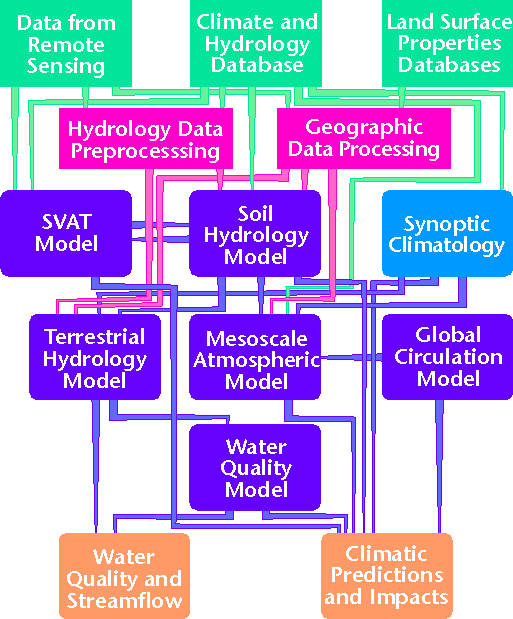 The Susquehanna River Basin Experiment
The Susquehanna River Basin Experiment
The Susquehanna River Basin Experiment (SRBEX) is the first of several
planned regional experiments being undertaken by memebers of the Penn
State/MSFC EOS interdisciplinary study team. SRBEX attempts to
integrate remotely sensed information, surface properties data, and a
number of climate, mesoscale atmospheric, and hydrology models to
evaluate the models' ability to simulate actual hydroclimatic conditions
and their potential for predicting the effects of future changes in
atmospheric composition and other factors which may affect
climate.
The main components of SRBEX are
- Acquiring and preprocessing
available geographic data describing surface topography,
geology, soils, hydrology, and landuse/landcover to extract
parameters required by other SRBEX components.
- Analyzing meteorological,
hydrologic, and related records to select representative
events for model simulation and establish empirical relationships
between watershed hydrologic responses and synoptic forcing.
- Extracting estimates of soil surface moisture and temperature from
remotely sensed imagery in the
context of soil-vegetation-atmosphere transfer (SVAT) models.
- Estimating soil moisture over time using a soil hydrology model (SHM) driven by
actual weather observations.
- Determining the spatial and temporal distribution of rainfall and
related parameters over the Susquehanna River Basin using a mesoscale atmospheric model .
- Using a global-scale general circulation
model to provide boundary conditions for the mesoscale model
for both current and modified (e.g., doubled carbon dioxide)
atmospheric compositions.
- Predicting precipitation infiltration, runoff, and stream flows
using a terrestrial hydrology model
(THM) driven by the rainfall and related data generated by the
mesoscale model.
- Estimating variations in stream water
chemistry and quality associated with the terrestrial
hydrographic conditions predicted by the models.
- Investigating the impact of climate
change on landscape evolution and human activities.
- Providing data retrieval and
manipulation tools for database management, visualization and
analysis of the results of experiments, and conversions between
the diverse scales, map projections, formats, computer platforms,
etc., used by different SRBEX components.
Regular meetings of SRBEX participants permit close coordination of the
activities outlined above and the definition of a series of linked-model simulations.
The diagram below shows the major categories of input data, the
principal analysis and modeling steps, and the relations between them.

Last change: 24 May 1995,
R. A. White / raw@essc.psu.edu
The Susquehanna River Basin Experiment